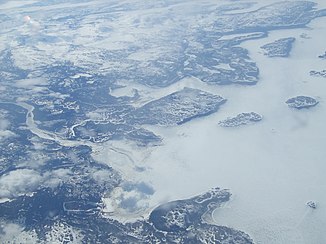Big River (Labrador)
| Big River | ||
|
Mouth of the Big River (left in the picture) |
||
| Data | ||
| location | Labrador , Newfoundland and Labrador ( Canada ) | |
| River system | Big River | |
| origin |
Little Michinappi Lake 54 ° 32 ′ 26 " N , 59 ° 26 ′ 10" W. |
|
| Source height | approx. 250 m | |
| muzzle |
Labrador Sea (Atlantic Ocean) Coordinates: 54 ° 50 ′ 15 " N , 58 ° 56 ′ 9" W 54 ° 50 ′ 15 " N , 58 ° 56 ′ 9" W |
|
| Mouth height | 0 m | |
| Height difference | approx. 250 m | |
| Bottom slope | approx. 4.2 ‰ | |
| length | 59 km | |
| Catchment area | 2849 km² | |
| Left tributaries | Micmac River, Otter Lake Brook | |
| Right tributaries | Standfords River | |
The Big River (English for "large river") is a 59 km long tributary of the Labrador Sea in the east of Labrador in the Canadian province of Newfoundland and Labrador .
River course
The Big River has its origin in Little Michinappi Lake (former name: White Bear Lake ), which is about 250 m high . The lake is part of a larger lake system, to which the Michinappi Lake , located further to the west, the White Bear Lake located to the northwest and several other unnamed lakes belong. The Big River leaves Little Michinappi Lake on its eastern bank. 1.5 km downstream, the Standsford River joins the Big River from the right. This flows 45 kilometers in a predominantly north-northeast direction, before turning east on its lower 13 kilometers. From the left, the Micmac River and Otter Lake Brook flow into the Big River. The mouth is located 30 km south-southeast of the Makkovik municipality . The Adlavik Brook runs a few kilometers north of the lower reaches . The catchment area of the Big River covers an area of 2849 km². In this a uranium deposit was discovered, the so-called Michelin Desposit . Black spruces grow along the course of the river .
Fish fauna
On the course of the Big River, at river kilometers 38.6 and 43.5, there are 3.1 and 4.6 m high waterfalls, which are sometimes viewed as obstacles for migratory fish . The following fish species occur in the river system: Catostomus catostomus (longnose sucker), anadromous and non-anadromous form of brook trout , Catostomus commersonii (white sucker) and Atlantic salmon (anadromous form and non-anadromous freshwater form Ouananiche).
Web links
- Big River at Natural Resources Canada
